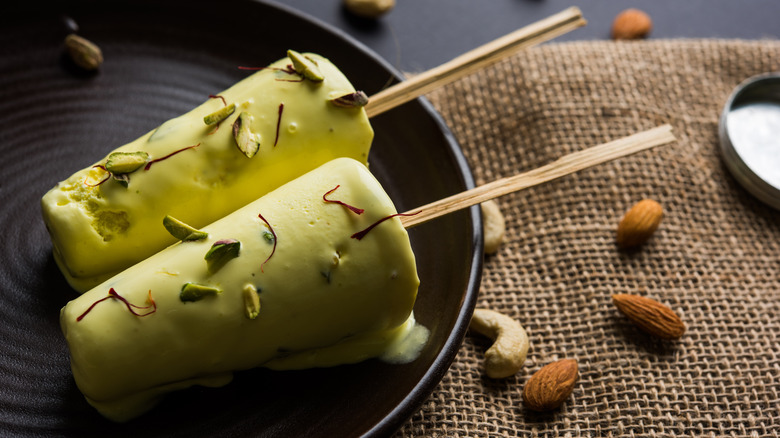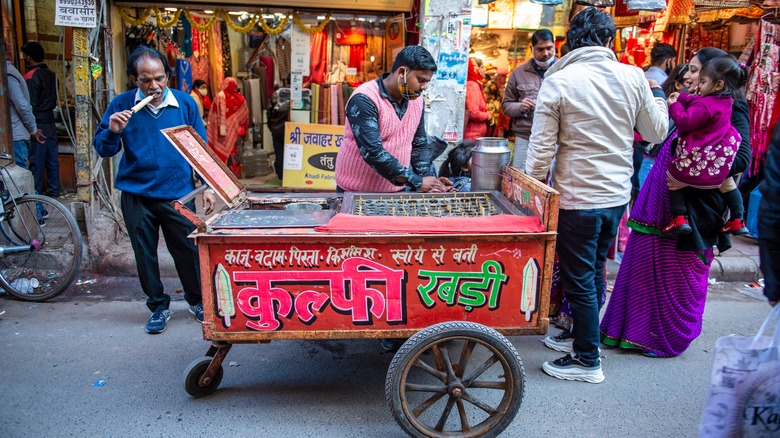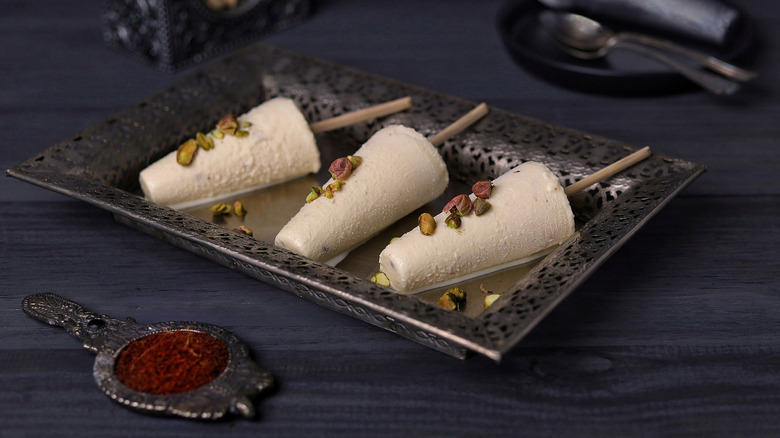What Is Indian Kulfi And How Is It Different From Ice Cream?
Almost every culture in the world has some form of ice cream, from Thailand's rolled-up I-Tim-Pad to Italy's gelato. After all, what's more tempting in the middle of a blazing summer than a cold, sweet, and readily available dessert?
For people in India and Pakistan, this cold classic is called kulfi. Sold by street vendors or made at home, it's a nostalgic treat for many in the South Asian diaspora.
Kulfi's origins, though fuzzy, are believed to trace back to the 16th century, when the treat was mentioned in the court records of Emperor Akbar. Indian Mughal cuisine, in general, was reportedly influenced by Persian cuisine, which might explain why the name "kulfi" actually comes from the Persian word for certain cone-shaped cups called "qulfe."
As Mansoor Ahmed, the founder of Heritage Kulfi in New Jersey, told us: "Kulfi stands out among the desserts because it brings together all these delicious and decadent ingredients into a single bite." But just as gelato is different from ice cream, kulfi also stands out from the frozen pack for its creamy and dense texture.
How kulfi is made
Traditionally, kulfi is made by simmering milk overnight in a type of wok called a kadai. The simmering process is complete once the milk develops a rich flavor from the caramelization of the milk proteins. This simmered milk solution is called rabri, which can be enjoyed on its own as a dessert since it forms a thick, creamy consistency. To make kulfi, however, rabri is flavored with regional ingredients such as pistachio, saffron, cardamom, malai (sweet cream), and mango, then frozen into molds to form its distinctive conical shape. (Traditionally, it was frozen using saltpetre — also known as potassium nitrate — though commercial freezers are more common these days.)
The end result is a dense dessert with a thick and creamy texture and a slightly nutty taste, which may be enhanced by adding additional nuts like pistachios. Kulfi is traditionally served on wooden sticks by street vendors called kulfiwallahs. At first glance, a stick of kulfi might resemble a popsicle.
How kulfi differs from ice cream
Though kulfi and ice cream are both frozen treats, they have some key differences. Unlike ice cream, which often uses eggs to add creaminess and stability, kulfi is made using only full-fat milk. This cooking method makes kulfi more stable than ice cream, so it's not as airy and doesn't melt as quickly.
Kulfi has a high butterfat content, making it very creamy, and it is dense due to its higher concentration of milk solids. Meanwhile, most other American ice creams only need to meet a minimum requirement of 10% dairy milkfat, leading to a fluffier texture since it is often whipped.
While kulfi is abundant in India, you might have to go a bit out of your way to find it in the United States. You may find kulfi in select South Asian grocery stores, or on the dessert menu of many Indian restaurants, alongside sweet treats like gulab jamun, rasmalai, and flavorful baklava. However, it could be difficult to find a place that exclusively serves kulfi in the U.S., the way you would be able to easily find an ice cream shop.
Either way, both ice cream and kulfi are delicious, and there's always an opportunity to do a personal taste test yourself!



